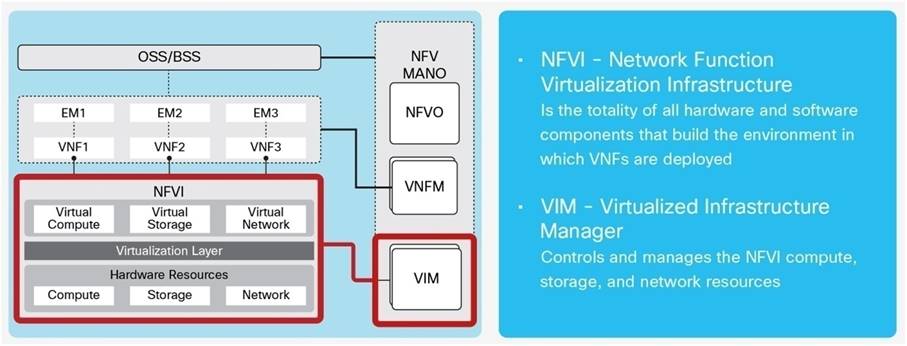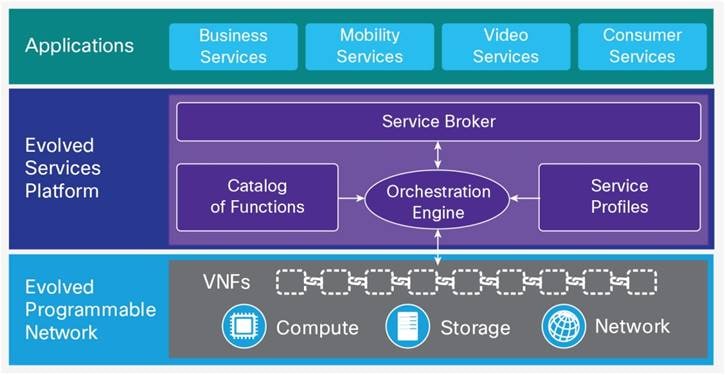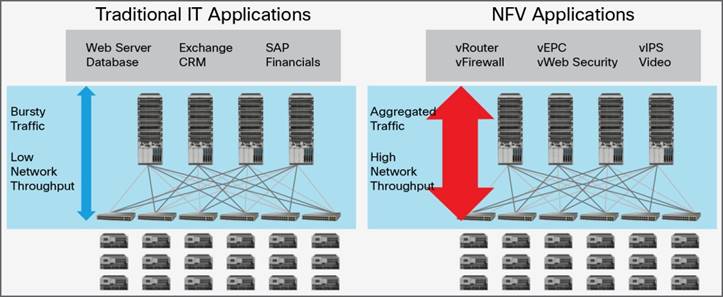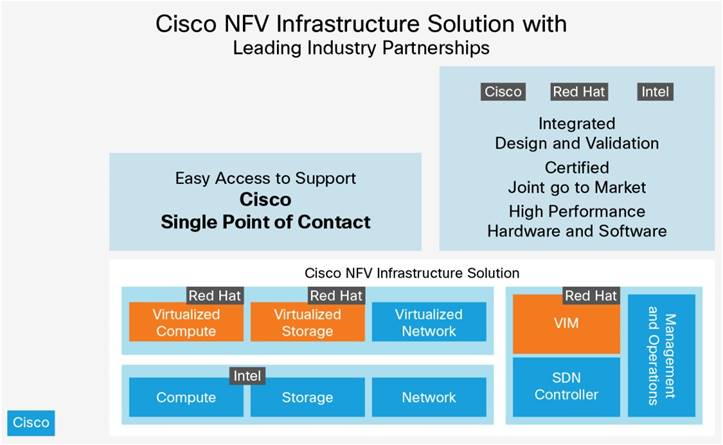Cisco NFV Infrastructure: Delivering Business Value White Paper
Available Languages
Executive Summary
The Cisco® NFV Infrastructure provides the compute, storage, networking infrastructure, and management and assurance capabilities to run network function virtualization (NFV) network services. It is a fully integrated solution that is tested and validated by Cisco. It’s a carrier-grade and robust solution that delivers high performance, availability, security, and scalability. The solution also automates lifecycle management that reduces TCO by up to 40 percent over white box solutions. EANTC and Light Reading have validated the features and benefits of the Cisco NFV Infrastructure in an independent report. This white paper provides an overview of the Cisco NFVI solution and focuses on the value proposition and business benefits.
Introduction
One of the most important developments in the network industry is the adoption of network function virtualization (NFV), which replaces network hardware with software running in the cloud. NFV is not about incremental improvements; it is a complete paradigm shift in network services and architecture. NFV unleashes the power of network cloud-based services, allowing for:
● New elastic services
● Decoupling of hardware and software
● Automating everything and simplifying network operations
● Reducing OpEx
● Increasing service revenue
In NFV, network functions run as software modules on x86 servers. An NFV infrastructure, or NFVI, provides the underlying compute, storage, and network resources required for NFV and is depicted in Figure1. This diagram shows how NFVI fits in the ETSI framework for NFV. The NFVI layer uses virtualization technology to map physical compute, storage, and network hardware to virtual compute, storage, and network resources. VNFs run on virtual machines provided by the NFVI layer. Additionally, NFVI includes Virtualized Infrastructure Manager (VIM), which is used to manage these resources.

In the Cisco framework, NFVI fits into the evolved programmable network (EPN), while the NFV orchestration system fits into the evolved services platform (ESP), as presented in Figure 2. The ESP is responsible for service catalogs, profiles, and orchestration, and the EPN provides the network resources to realize these services.

The body of this white paper discusses cloud scale requirements that are unique to NFVI, presents the Cisco NFV Infrastructure solution, and presents the business value of the Cisco NFV Infrastructure.
NFVI Value Proposition
Common questions are “Why do I need specialized infrastructure for NFV?” and “Why not use my existing IT data center infrastructure?” While there are many similarities between NFVI and standard IT infrastructure, there are also some important differences (Figure 3). The primary difference is that service provider network functions are much more bandwidth intensive than IT applications. NFV applications require high network bandwidth and compute capacity (Figure 4) to deliver maximum packet throughput. Traditional IT data centers are designed for high levels of north-south oversubscription (up to 20:1) and therefore will not provide the level of throughput necessary in service provider networks. In addition, service providers require carrier-class infrastructure for network services. More specifically, they require:
● High levels of service availability
● High levels of network performance
● High levels of manageability and assurance
● Simplified and automated operations


Cisco Best-in-Class NFVI Solution
The Cisco NFV Infrastructure solution uses best-in-class hardware and software components coupled with an integrated and certified design that guarantees:
● High performance
● High availability
● Automated network operations
The Cisco NFV Infrastructure solution is depicted in Figure 5 and consists of best-in-class hardware and software components from Cisco, Red Hat, and Intel. Cisco provides a single point of contact for systems support and maintenance.

Compute: NFVI servers are best-in-class Cisco UCS® rack and blade servers providing high levels of scalability, availability, and manageability. Best-in-class Linux and KVM hypervisors are provided by Red Hat.
Storage: NFVI storage uses best-in-class open-source CEPH provided by Red Hat running on Cisco UCS.
Network: NFVI networks use best-in-class Cisco Nexus® data center switches and ASR carrier-class routers. Additionally, virtual switching is provided using open source virtual switch (OVS) and the Cisco virtual switch (VTF). Customers can plug in Cisco VTS as an SDN module for virtual networking and service chaining.
VIM: A combination of Cisco software and Red Hat OpenStack. Cisco software is added to Red Hat’s OpenStack to deliver required carrier-class features. This includes lifecycle management to reduce overall TCO.
Infrastructure management and operations: Cisco best-in-class Cisco UCS-D provides a single-interface network, system, service assurance, and performance management, including the ability to centralize operations of NFVI PODs spread across multiple locations.
Cisco NFV Infrastructure Value Proposition
The Cisco NFV Infrastructure helps service providers lower NFVI TCO while accelerating service velocity. The integrated, tested, and certified carrier-class architecture is crucial to delivering business value. Some of the primary characteristics of the NFVI solution are:
Prepackaged solution:
● Integrated POD delivery model
● Simple to install, operate, and manage
● Preintegrated and validated
Flexibility in the types of VNFs that can be deployed:
● High-performance VNFs
● Custom-tuned Cisco VNFs for maximum performance
● Bare-metal applications
● General multivendor and open-source VNFs
Carrier-class availability:
● HA built across the NFVI stack
● OpenStack HA
● Cisco UCS compute HA
● Cisco Nexus ToR HA
● Telemetry and visibility to identify hot spots
● RHEL kernel HA
Cisco validated solution:
● Simple, automated installation
● Cisco and third-party VNF validation
● Cisco secured and hardened
Cisco NFV Infrastructure Business Case
A common question is “Why should we use a Cisco integrated solution when we can create our own NFVI solution using low-cost white box servers?” While it is possible to architect, design, integrate, and test a white box solution, it is a complex job with many expenses and risks.
OpenStack is usually the favored choice for NFVI cloud computing technology. It has many benefits; however, OpenStack lifecycle management is both complex and labor intensive. OpenStack installations and upgrades might take weeks and involve many risks, including the possibility of a software rollback because of upgrade problems. This is because OpenStack is a suite of open-source software that is not very user friendly. Cisco has solved this problem by automating Red Hat OpenStack installations and upgrades to:
● Automatically install or upgrade OpenStack in hours rather than a week
● Make sure that the installation configuration is correct
● Take advantage of Red Hat’s robust OpenStack implementation
The primary benefits of the Cisco NFV Infrastructure compared with do it yourself (DIY) are summarized in Figure 6. The main point is that if service providers choose DIY, they will need an OpenStack engineering team that includes operations, network engineering, and software development. If they choose the Cisco NFV Infrastructure, they can manage with a more traditional systems operations team without the OpenStack software development expertise.
Some of the problems of maintaining a software engineering team are:
● Ongoing expense of team
● Difficulty in hiring team: OpenStack, software, and networking skills hard to hire
● Difficulty in retaining the team: poaching and turnover are big problems
For DIY the service provider will be responsible for:
● System design
● Overall solution support and troubleshooting
● Software installations and upgrades
● Bug finding and fixing
● OpenStack maintenance
● Regression testing
● Dealing with multiple vendors blaming each other when a catastrophic fault occurs
All of these items add risk of service outage or service degradation because of poor performance.

In a total cost of ownership (TCO) analysis, the Cisco NFV Infrastructure solution proved to be more cost effective than a white box solution. The results of this analysis are presented in Figure 7 and Figure 8.


While the equipment expense of the white box solution is 29 percent lower than the Cisco UCS, the labor cost for the DIY approach is significantly higher than the Cisco NFV Infrastructure solution. This is because of the increased expense of hiring OpenStack software engineers and the time associated with complex software upgrades. Overall, this resulted in a TCO savings of 40 percent for an NFVI with 300 servers.
In addition to the TCO benefits, the Cisco NFV Infrastructure also provides the following business benefits:
● Reduces the risk of service outages because of smaller and more controlled maintenance windows
● Improves security because of Red Hat’s patches for OpenStack and Linux vulnerabilities
● Increases service velocity because of shortening the time for system deployment
External Validation of NFVI: EANTC Testing
EANTC and Light Reading carried out a set of external tests on the Cisco NFV Infrastructure. The two phases of tests were:
1. Phase 1: VNF interoperability
2. Phase 2: covered performance and scale
The results of the tests proved:
● Carrier-class high availability
● NFV-ready high performance
● Simple operation with single-interface management
A detailed test reported can be downloaded at http://www.lightreading.com/nfv/nfv-tests-and-trials/validating-ciscos-service-provider-virtualization-and-cloud-portfolio/d/d-id/714092.
Conclusion
Many service providers are starting to deploy NFV solutions that promise to improve business agility and increase service revenue. In order to make sure of the success of these deployments, it is essential that NFV applications run on top of a solid base compute, storage, and network architecture. Standard IT cloud infrastructure is not well suited to NFV because it is not designed for high-bandwidth service provider network applications. The Cisco NFV Infrastructure provides service providers with Cisco integrated, tested, and certified solutions to run NFV network services. The primary benefits of the Cisco NFV Infrastructure are:
● Cisco packaged, tested, and certified
● High performance and scalability
● High-availability architecture
● Single-interface management
● Automated Red Hat OpenStack
● Lower TCO than alternatives
● Faster time to NFV network services
For more information about the Cisco NFV Infrastructure, contact your Cisco sales representative.
 Feedback
Feedback